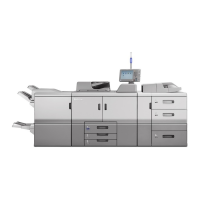3. Select a number that is [ Not Programd.].
Press [ Previous] or [ Next] to scroll through the list.
4. Press [Change] for [Paper Name].
5. Enter the name of the paper, and then press [OK].
6. Press [Change] for [Paper Size].
7. Select a paper size, and then press [OK].
8. Press [Change] for [Paper Weight].
9. Specify the paper's weight, and then press [OK].
Press [Change] if you changed the paper weight.
10. Press [Change] for [Paper Type].
11. Specify the paper type, and then press [OK].
Press [Change] if you changed the paper type.
12. Specify [Coated Paper Type], [Paper Color], [Prepunched or Not], [Apply Duplex], and
[Apply Auto Paper Select] according to the paper's features.
If you change the [Coated Paper Type], [Paper Color], or [Prepunched or Not] and press [OK], a
message appears to notify you that the [Advanced Settings] will be initialized. To apply the
changes for those settings, select [Change]. To cancel the changes, select [Do not Change].
13. Press [OK].
14. Press [Exit].
15. Press the [Paper Setting] key.
You can also close the [Tray Paper Settings] screen by pressing [Exit].
• If you want to use glossy paper, select [Glossy] for [Coated Paper Type]. If you want to use matte
paper (including silk, dull, and satin paper), select [Matted] for [Coated Paper Type].
• If you use color paper that does not appear as keys, select an appropriate setting depending on
the color density of the paper from the following:
8. Adding Paper and Toner
150

